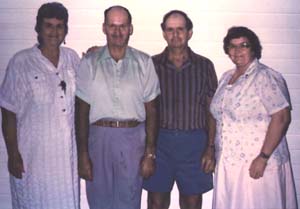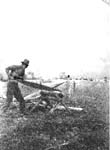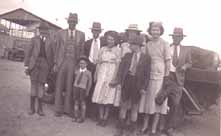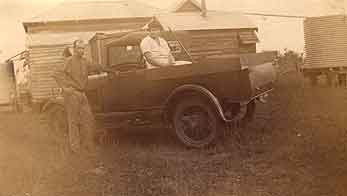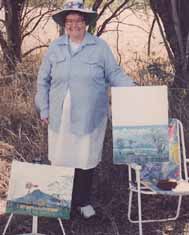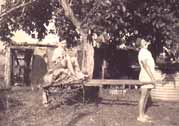
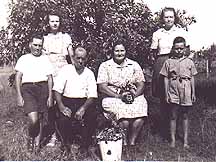
The Tyrrells of Alton Downs/Nine Mile
Our name, Tyrell originated from Ireland, Thomas and Mary. They migrated to Victoria, Australia with three children, Mary, Catherine and Matthew. They settled at Hamilton in Victoria and had two more children — Ellen and Thomas. The latter was born October 1, 1844, and he moved to the Springsure district as an adult, He married Eleanor Martha Gill in 1873 at the house of Eleanor's parents, Thomas George and Martha Mulvena Gill by the officiating Catholic Minister Nazzareno Clementoni. M.B.
A note on Martha Mulvena Gill — she turned her home into a maternity home for all the young married women after she had completed her own family in the 1860s, including her own married daughters. The Gills migrated from Pambula, N.S.W. in the late 1960s to Springsure.
Thomas and Eleanor had three sons — George, Joseph and Matthew. As it was gold mining times at Canoona, Thomas and the sons moved to Glenmore on the north side of Rockhampton.
George moved to the coast, became a cabin boy on the coast vessels, settled in North Queensland, had a big family and died at Innisfail, 1954.
Joseph was drowned in the Fitzroy River as a school boy of 11 years old and was buried at Rockhampton cemetery in 1888.
Matthew started work making ship tanks at the age of nine years at Canoona. In his late life, he was partly deaf from his lifelong days with tanks.
In the year, 1902, Matthew and his father, Thomas moved to the Nine Mile area farm, known as "Stoney Point" farm. It was drought ridden and a mouse plague was present.
Thomas Tyrrell was a small man, smoked long stem clay pipes and lived a quiet life. He died of pneumonia at the Rockhampton Base Hospital, aged 85 and was buried at the Alton Downs cemetery 3.12.1929. His son Matthew cared for him until death.
Matthew settled down to married life after his father's death. He married Dorothy Catherine Watts from the Nine Mile. There are four children, namely Irene, Marjorie, George and Donald.
Matthew was a contract builder, he was very creative in all his works, cementing, word work, making his tools from a foot pressured charcoal heat bellows, mechanical work, gardening etc. In his early days, he used a horse and dray or springcart to get to his work areas around the district. After marriage, he bought a new T model Ford, the first in the Nine Mile area.
As it depression years, Matthew grew all his own vegetables, on the farm which consisted of black soil, stones and some sandy soil. He had established a good well with a windmill for watering both garden and his Hereford cattle. As the water was quite brackish, small trenches were used to allow the water to soak the vegetable garden, Matthew also had a few cows for milking for the household supplies, a cream separator for making butter and an animal was butchered when required for meat. He preserved the meat in a large wine cask using brine and saltpetre as there was no refrigeration, ice or coolers available in the country then.
As the eldest girl Irene grew she found herself helping her father in many ways — book work, mustering, milking the cow, making butter, gardening, vehicle repairs, apart from the ususal homework from school.
All the four children attended the Alton Downs State School. We mostly worked three and a half miles on black soil tracks along Hunts Road. During the second World War years, 1939-45, the convoys of American soldiers would take over the road slowly, so walking on the rough ground was difficult at times. The water crossing on Hunts Road could be dangerous when in flood. Our school holidays were often spent with our grandparents, the Watts family about a mile away from our home. Our neighbours were the Watts, Rosel, Stracey and Hunt families. Most of the members of these families attended the Dalma Road State School which closed in 1934. The senior members above them attended the Nine Mile (Windmere) State School which closed C1908, This school was situated on the Nine Mile Reserve.
Our sporting activities were quite simple, being mostly war years, we created our own fun, make-believe plays etc. Horse riding was a novelty. Tennis at the Alton Downs School court (ant bed type) was very popular, Irene having won the Cup at the end of her school years there in 1944. Our teacher, Mr. Henry Lawrence was the C.Q. singles representative in his days.
The rail motor which went through to Ridgelands was our mode of travel to Rockhampton for our domestic Home Science classes each Friday. Irene and Marjorie would board it at Milyando Station, off Hunts Road. The class took place at the Technical College in Bolsover Street, Rockhampton. We learnt dressmaking and cookery with two 'three hour" exam papers at the end of studies then.
